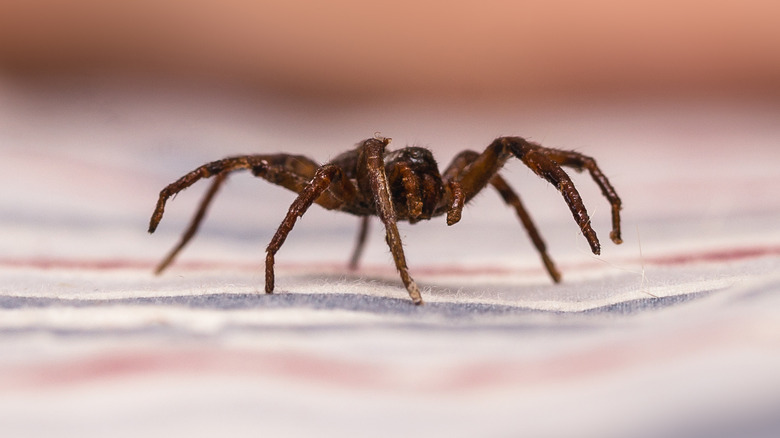How To Tell The Difference Between MRSA And A Spider Bite
For many of us, the thought of getting bitten by a spider is one of our worst fears. Despite humans being significantly larger organisms, it's not uncommon for us to cringe, scream, and run away at the sight of a spider. Some researchers hypothesize that this phenomenon may begin early in life and serve an evolutionary purpose for humans. Scientists at the Max Planck Institute for Human Cognitive and Brain Sciences conducted a study on babies who were shown photos of spiders, which triggered their pupils to widen. This natural reaction suggested an inherent stress response to spiders.
While some people may wish for these creepy crawlers to be completely eradicated from the earth, they're here to stay — and so is their venom. Certain species of spiders are poisonous to humans, like the black recluse spider and the black widow spider, making their bites more dangerous.
According to the BC Centre for Disease Control, the lesions associated with methicillin-resistant Staphylococcus aureus (MRSA) can resemble the bite of a spider. MRSA is a staph infection that occurs when bacteria enter an open wound, like a cut or bite, as explained by Johns Hopkins Medicine. There are two categories of MRSA, including the healthcare-associated strain (HA-MRSA) and the community-associated strain (CA-MRSA).
It's important to be able to distinguish between a spider bite and a MRSA infection, as both can be life-threatening in severe cases. Although both wounds may appear similar, there are a few key differences to keep in mind.
The difference between MRSA and a spider bite
Both MRSA and spider bites can cause red, swollen, and painful areas on the skin, as described by Baton Rouge General. Considering how similar MRSA lesions and spider bites look, it can be difficult to tell them apart at first glance.
According to Difference Between, one distinguishable aspect of a wound infected by MRSA is the existence of white or yellow pus. You may also develop a fever if you have a staph infection, and the affected skin will feel warm when touched. MRSA can spread to different parts of the body and may be resistant to some forms of antibiotic treatment (per WebMD). The infection can be transmitted to others by sharing personal items or through skin-to-skin contact, so athletes, students, and military personnel should be mindful of their increased risk of contracting the infection, as explained by the Centers for Disease Control and Prevention (CDC).
When a non-toxic spider bite is responsible for the wound, the area won't feel warm and there will be no white or yellow pus present. Nausea, vomiting, chills, and body aches are additional symptoms that someone may notice if they've been bitten. The spider bite may have a pale center with a red ring around the area, or it could turn into an ulcer with dead skin surrounding it.
If you experience symptoms of MRSA or a spider bite, you should reach out to your doctor so they can diagnose which of these factors is responsible.
Treatment for MRSA wounds and spider bites
Another difference between spider bites and MRSA wounds is the way they are diagnosed and treated. If you visit a doctor to inquire about your lesions, they may ask if you or anyone else saw a spider bite you. If a spider was seen, they may ask for further details about the arachnid so the species can be identified (per Mayo Clinic).
Generally, many spider bites heal on their own and can be treated at home. Bites from venomous spiders, like the brown recluse, can be slower to heal and may need further assistance. A black widow bite may cause severe pain or become life-threatening. In this case, a doctor might give you intravenous antivenom.
In order to prevent infection, it's important to keep the wound as clean as possible. It should be cleaned with mild soap and water and treated with antibiotic ointment three times a day. If your spider bite is swollen and painful, you can place a cool compress on the bite every hour for 15 minutes to relieve the discomfort. It may be recommended by a doctor that you take pain medications or muscle relaxants and that you receive a tetanus shot in some cases.
MRSA diagnosis and treatment require a different approach. First, a doctor will typically take a skin sample or collect discharge from the infected area, as explained by the Cleveland Clinic. The wound may also be drained by a doctor. Oral antibiotics are usually used to treat mild infections. In the case of severe infections, antibiotic medication may be administered by intravenous injection.



